1998 PONTIAC BONNEVILLE warning light
[x] Cancel search: warning lightPage 193 of 395
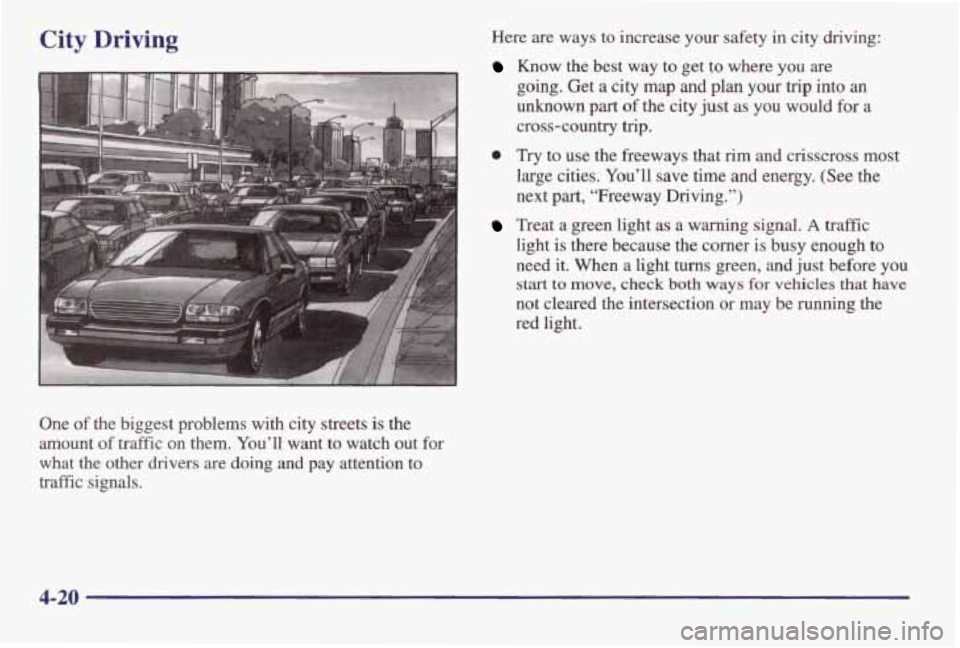
City Driving
One of the biggest problems with city streets is the
amount
of traEc on them. You’ll want to watch out for
what the other drivers are
doing and pay attention to
traffic signals. Here are ways
to increase your safety in city driving:
Know the best way to get to where you are
going. Get
a city map and plan your trip into an
unknown part of the city just as you would for a
cross-country trip.
0 Try to use the freeways that rim and crisscross most
large cities. You’ll save time and energy. (See the
next
part, “Freeway Driving.”)
light
is there because the corner is busy enough to
need
it. When a light turns green, and just before you
start to move, check both ways for vehicles that have
not cleared the intersection or may be running the
red light.
Treat a green light as a warning signal. A traffic
4-20
Page 198 of 395
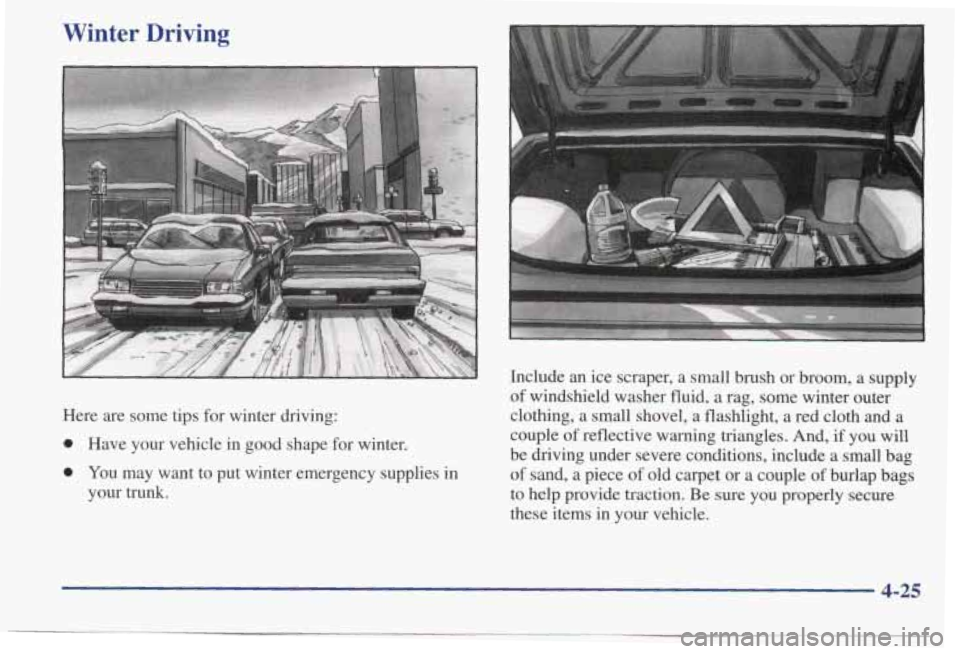
Winter Driving
Here are some tips for winter driving:
0 Have your vehicle in good shape for winter.
0 You may want to put winter emergency supplies in
your trunk. Include an
ice scraper, a small brush or broom, a supply
of windshield washer fluid,
a rag, some winter outer
clothing, a small shovel, a flashlight, a red cloth and a
couple of reflective warning triangles. And, if you will
be driving under severe conditions, include a small bag of sand,
a piece of old carpet or a couple of burlap bags
to help provide traction. Be sure you properly secure
these items in your vehicle.
4-25
Page 210 of 395
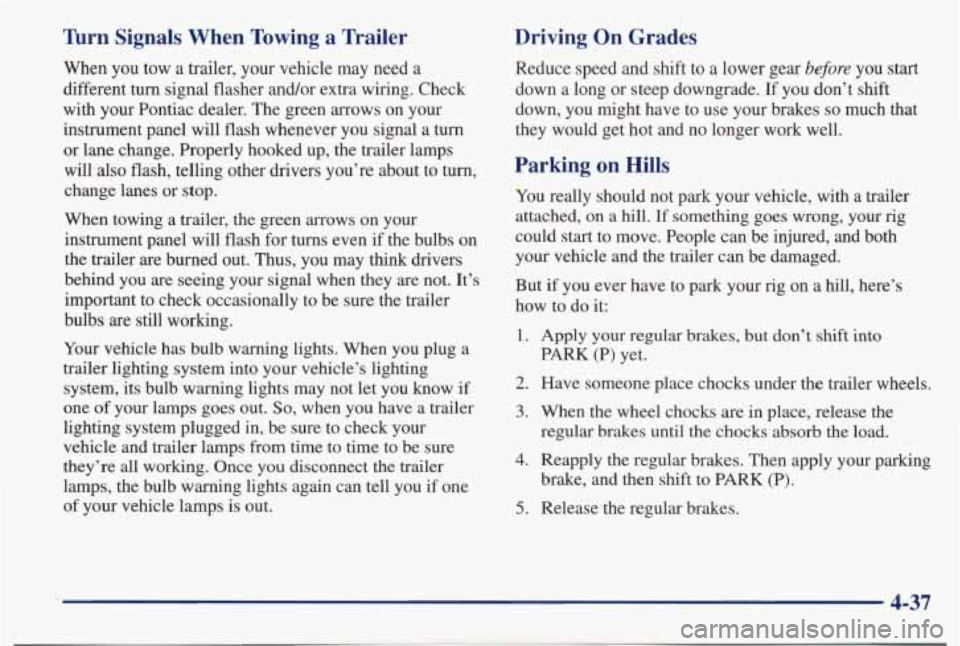
Tbrn Signals When Towing a Trailer
When you tow a trailer, your vehicle may need a
different turn signal flasher and/or extra wiring. Check
with your Pontiac dealer. The green arrows on your
instrument panel will flash whenever
you signal a turn
or lane change. Properly hooked up, the trailer lamps
will also flash, telling other drivers you’re about to turn,
change lanes or stop.
When towing a trailer, the green arrows on your
instrument panel will flash for turns even if the bulbs
on
the trailer are burned out. Thus, you may think drivers
behind you are seeing your signal when they are not. It’s
important to check occasionally to be sure the trailer
bulbs are still working.
Your vehicle has bulb warning lights. When you plug a
trailer lighting system into your vehicle’s lighting
system, its bulb warning lights may not let you know
if
one of your lamps goes out. So, when you have a trailer
lighting system plugged in, be sure to check your
vehicle and trailer lamps from time to time to be sure
they’re all working. Once you disconnect the trailer
lamps, the bulb warning lights again can tell
you if one
of your vehicle lamps is out.
Driving On Grades
Reduce speed and shift to a lower gear before you start
down a long or steep downgrade.
If you don’t shift
down, you might have to use your brakes
so much that
they would get hot and no longer work well.
Parking on Hills
You really should not park your vehicle, with a trailer
attached, on a hill. If something goes wrong, your rig
could start to move. People can be injured, and both
your vehicle and the trailer can be damaged.
But if
you ever have to park your rig on a hill, here’s
how to do it:
1.
2.
3.
4.
5.
Apply your regular brakes, but don’t shift into
PARK (P) yet.
Have someone place chocks under the trailer wheels.
When the wheel chocks are in place, release the
regular brakes until
the chocks absorb the load.
Reapply the regular brakes. Then apply your parking
brake, and then shift to PARK (P).
Release the regular brakes.
4-37
Page 228 of 395
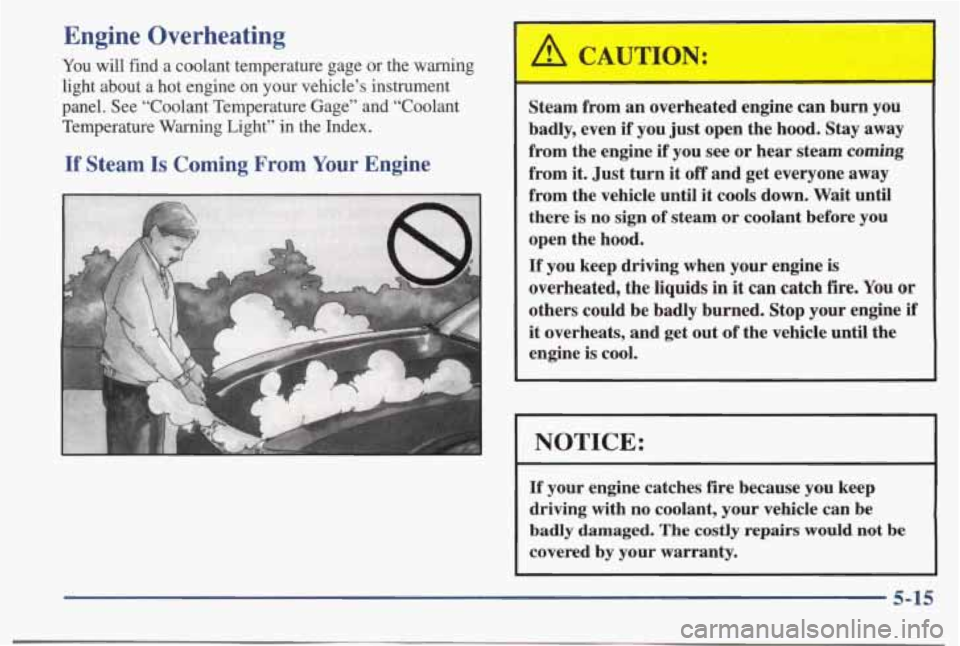
Engine Overheating
You will find a coolant temperature gage or the warning
light about a hot engine on your vehicle’s instrument
panel. See “Coolant Temperature Gage” and “Coolant Temperature Warning
Light” in the Index.
If Steam Is Coming From Your Engine
1
A CAUTION:
Steam from an overheated engine can burn you
badly, even if you just open the hood. Stay away
from the engine if you see or hear steam
coming
from it. Just turn it off and get everyone away
from the vehicle until it cools down. Wait until
there is no sign
of steam or coolant before you
open the hood.
If you keep driving when your engine is
overheated, the liquids in it
can catch fire. You or
others could be badly burned. Stop your engine if
it overheats, and get out of the vehicle until the
engine is cool.
I
NOTICE:
If your engine catches fire because you keep
driving with no coolant, your vehicle can be
badly damaged. The costly repairs would not be
covered by your warranty.
5-15
Page 274 of 395
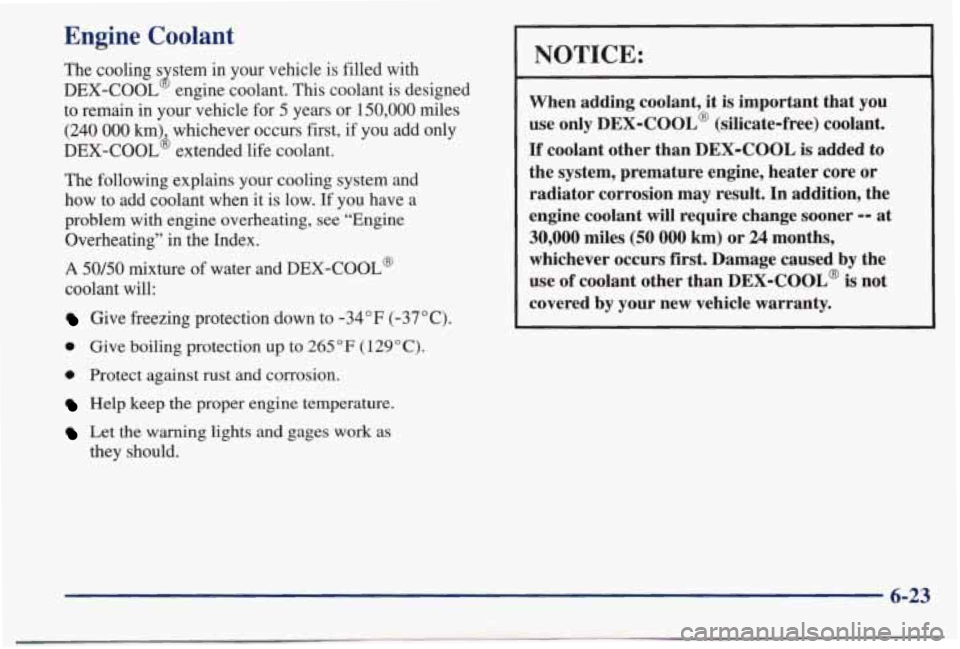
Engine Coolant
The cooling s stem in your vehicle is filled with
DEX-COOL
8 engine coolant. This coolant is designed
to remain in your vehicle for
5 years or 150,000 miles
(240 000 km) whichever occurs first, if you add only
DEX-COOL’ extended life coolant.
The following explains your cooling system and
how to add coolant when it is low. If you have a
problem with engine overheating,
see “Engine
Overheating”
in the Index.
A 50/50 mixture of water and DEX-COOL@
coolant will:
Give freezing protection down to -34°F (-37°C).
0 Give boiling protection up to 265 “F (129°C).
0 Protect against rust and corrosion.
Help keep the proper engine temperature.
Let the warning lights and gages work as
they should.
NOTICE:
When adding coolant, it is important that you
use only DEX-COOL@ (silicate-free) coolant.
If coolant other than DEX-COOL is added to
the system, premature engine, heater core or
radiator corrosion may result. In addition, the
engine coolant
will require change sooner -- at
30,000 miles (50 000 km) or 24 months,
whichever occurs first. Damage caused by the
use of coolant other than DEX-COOL@
is not
covered by your new vehicle warranty.
6-23
Page 280 of 395
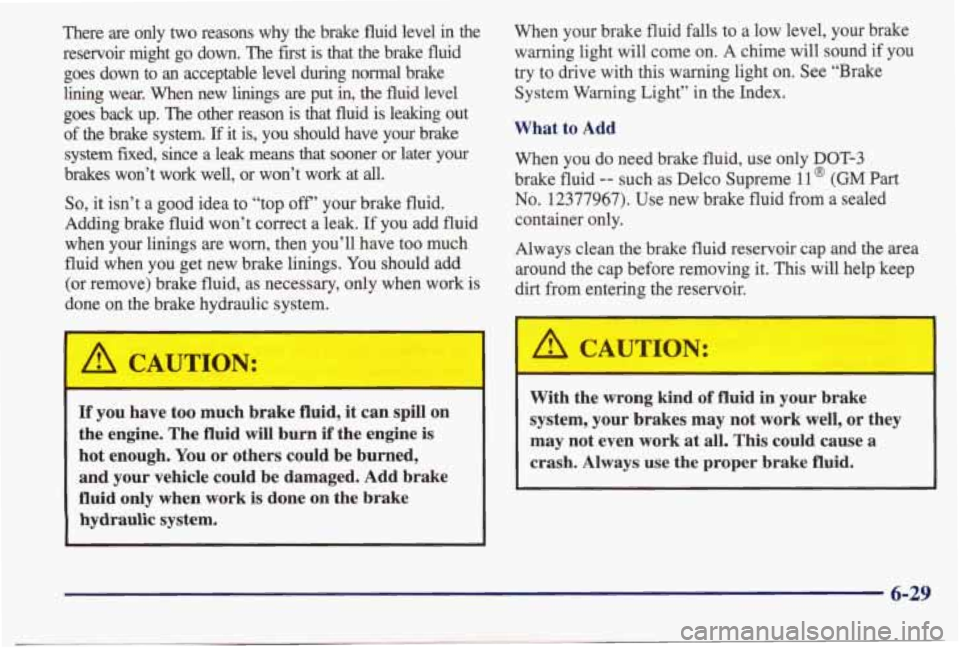
There are only two reasons why the brake fluid level in the
reservoir might go down. The first is that the brake fluid
goes down to
an acceptable level during normal brake
lining wear. When new linings are put in, the fluid level
goes back up. The other reason is that fluid is leaking out
of the brake system.
If it is, you should have your brake
system fixed, since a leak means that sooner or later your
brakes won’t work well, or won’t work at
all.
So, it isn’t a good idea to “top off’ your brake fluid.
Adding brake fluid won’t correct a leak.
If you add fluid
when your linings
are worn, then you’ll have too much
fluid when you get new brake linings. You should add
(or remove) brake fluid, as necessary, only when work
is
done on the brake hydraulic system.
I A CAUTION:
When your brake fluid falls to a low level, your brake
warning light will come on.
A chime will sound if you
try to drive with this warning light on. See “Brake
System
Warning Light” in the Index.
What to Add
When you do need brake fluid, use only DOT-3
brake fluid -- such as Delco Supreme 11 @ (GM Part
No. 12377967). Use new brake fluid from a sealed
container only.
Always clean the brake fluid reservoir cap and the area
around the cap before removing it.
This will help keep
dirt from entering the reservoir.
If you have too much brake fluid, it can spill on
the engine. The fluid will burn if the engine
is
hot enough. You or others could be burned,
and your vehicle could be damaged. Add brake
fluid only when work is done on the brake
hydraulic system.
I b, CAUTION:
With the wrong kind of fluid in your brake
system, your brakes may not work well, or they
may not even work
at all. This could cause a
crash. Always use the proper brake fluid.
6-29
Page 374 of 395
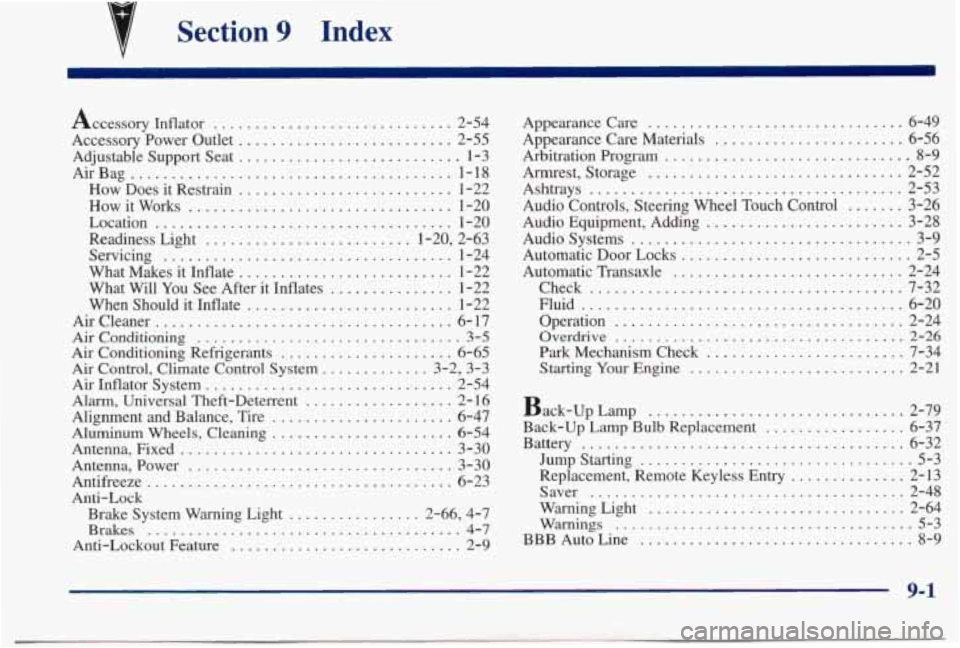
Section 9 Index
Accessory Inflator ............................. 2-54
Accessory Power Outlet
.......................... 2-55
Adjustable Support Seat
........................... 1-3
AirBag
....................................... 1-18
How Does it Restrain
... .................. 1-22
How
it Works ................................ 1-20
Location
.................................... 1-20
Readiness Light
......................... 1.20. 2.63
Servicing
................................... 1-24
What Makes it Inflate
.......................... 1-22
What Will
You See After it Inflates ............... 1-22
When Should it Inflate
......................... 1-22
Air Cleaner .................................... 6- 17
Airconditioning
................................ 3-5
Air Conditioning Refrigerants ..................... 6-65
Air Control. Climate Control System
............. 3-2. 3-3
Air Inflator System
.............................. 2-54 Appearance Care
............................... 6-49
Appearance Care Materials
....................... 6-56
Arbitration Program
.............................. 8-9
Armrest. Storage
............................... 2-52
Ashtrays
...................................... 2-53
Audio Equipment. Adding
........................ 3-28
Audio Systems
.................................. 3-9
Automatic Door Locks
............................ 2-5
Automatic Transaxle
............................ 2-24
Check
.. : ................................... 7-32
Fluid
....................................... 6-20
Operation
................................... 2-24
Overdrive
................................... 2-26
Park Mechanism Check ........................ 7-34
Audio Controls. Steering Wheel Touch Control
....... 3-26
Starting Your Engine
.......... ......... 2-21
Alarm. Univ6rsal Theft-Deterrent .................. 2- 16
Alignment and Balance. Tire
...................... 6-47 Back-up amp 2-79
Aluminum Wheels. Cleaning
...................... 6-54 Back-up Lamp Bulb Replacement 6-37
Antenna. Fixed
................................. 3-30 Battery 6-32
Antenna. Power
................................ 3-30 Jumpstarting 5-3
Antifreeze
..................................... 6-23 Replacement. Remote Keyless Entry 2-13
Anti-Lock Saver 2-48
Brakes ...................................... 4-7 Warnings 5-3
Anti-Lockout Feature ............................ 2-9 BBB Auto Line 8-9
...............................
.................
.......................................
.................................
..............
......................................
............................... Brake System Warning Light .......... . . 2-66. 4-7 WarningLight 2-64 ....................................
.................................
9-1
Page 375 of 395
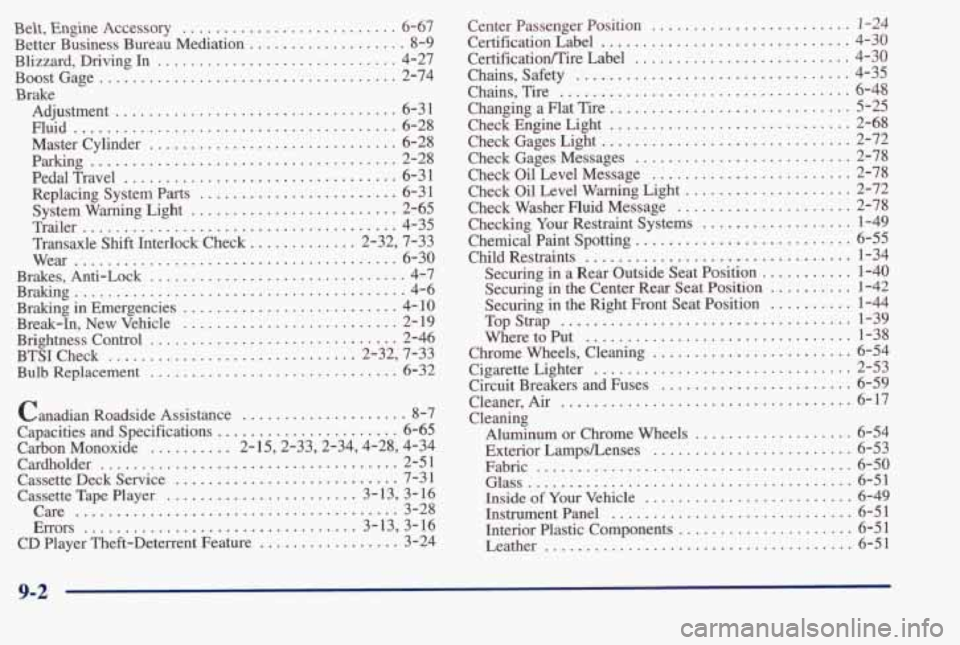
Belt. Engine Accessory .......................... 6-67
Better Business Bureau Mediation
................... 8-9
Blizzard. Driving In
............................. 4-27
Boost Gage
.................................... 2-74
Adjustment
.................................. 6-3 1
Master Cylinder
.............................. 6-28
Parking ..................................... 2-28
Pedal Travel
................................. 6-3 1
Replacing System Parts
........................ 6-31
System Warning Light
......................... 2-65
Trailer
...................................... 4-35
Transaxle
Shift Interlock Check ............. 2-32. 7-33
Wear
....................................... 6-30
Brakes.Anti -Lock ............................... 4-7
Braking
........................................ 4-6
Braking in Emergencies
.......................... 4- 10
Break-In.
New Vehicle .......................... 2- 19
Brightness Control
.............................. 2-46
BTSI Check
.............................. 2-32, 7-33
Bulb Replacement
.............................. 6-32
Brake
Fluid
....................................... 6-28
Canadian Roadside Assistance
.................... 8-7
Capacities and Specifications
...................... 6-65
Carbon Monoxide
.......... 2.15.2.33.2.34.4.28. 4.34
Cardholder
.................................... 2-51
Cassette Deck Service ........................... 7-31
Cassette Tape Player
....................... 3-13. 3-16
Care
....................................... 3-28
Errors
................................. 3-13, 3-16
CD Player Theft-Deterrent Feature ................. 3-24 Center Passenger Position
. . , ........ ..... 1-24
CertificationLabel .............................. 4-30
CertificationEire Label
.......................... 4-30
Chains, Safety
................................. 4-35
Chains, Tire
................................... 648
Changing a Flat Tire .............................. 5-25
Check Engine Light
............................. 2-68
Check Gages Light
.............................. 2-72
Check Gages Messages
.......................... 2-78
Check Oil Level Message
........................ 2-78
Check
Oil Level Warning Light .................... 2-72
Check Washer Fluid Message
..................... 2-78
Checking
Your Restraint Systems .................. 1-49
Chemical Paint Spotting
.......................... 6-55
Securing
in the Center Rear Seat Position .......... 1-42
ChildRestraints ................................ l-34
Securing in a Rear Outside Seat Position ........... 1-40
Securing
in the Right Front Seat Position .......... 1-44
TopStrap ................................... 1-39
WheretoPut
................................ l-38
Chrome Wheels, Cleaning ........................ 6-54
Cigarette Lighter
............................... 2-53
Circuit Breakers and Fuses
....................... 6-59
Cleaner,
Air ................................... 6-17
Cleaning Aluminum or Chrome Wheels
................... 6-54
Exterior Lamps/Lenses
........................ 6-53
Fabric
...................................... 6-50
Glass
....................................... 6-51
Inside
of Your Vehicle ......................... 6-49
Instrument Panel ............................. 6-51
Interior Plastic Components
..................... 6-51
Leather
..................................... 6-51
9-2